What is Software Development Methodology? 10 Key Methodologies
Contents
Methodologies in software development are essential in the development of software systems. For their day-to-day operations, custom software development firms employ a variety of software development approaches. Each of them has its own set of perks and downsides. The primary goal of these approaches is to ensure smooth software development in accordance with project specifications.
These methodologies are frameworks for structuring, planning, and controlling the process of developing an information system. Although it does not involve any technical aspects, software development methodology requires good planning for the software development life cycle by the development organization.
What is Software Development Methodology?
A software development methodology is a map of how an organization creates software. It generally takes the form of defined phases, created to describe the “how” and the life cycle of a piece of software.
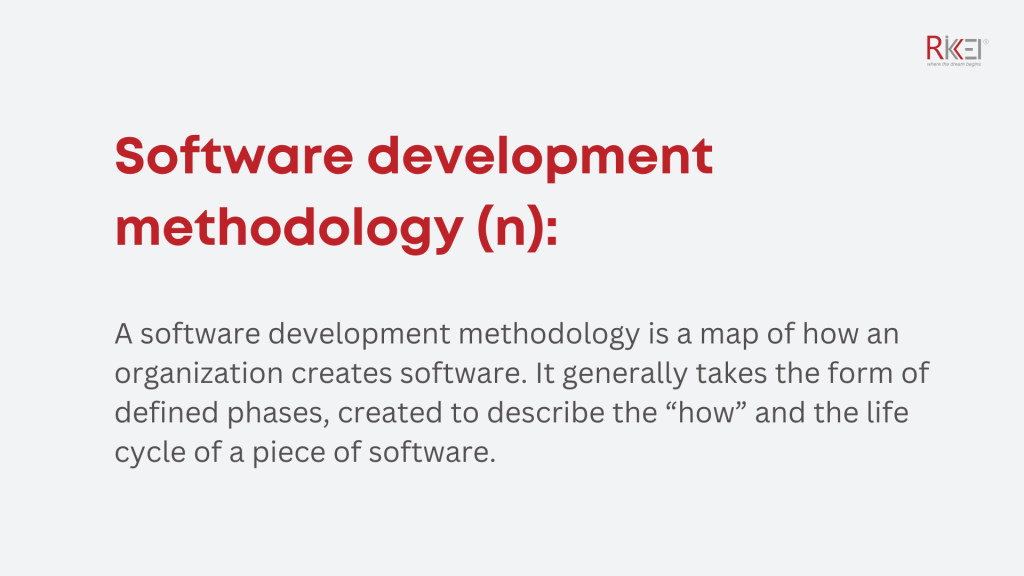
There are different methodologies within software development that are intended to support the software throughout its software development life cycle. These models are chosen depending on the project’s,its developers’ needs and preferences.
- The needs of the business
- The developer’s design preferences
- The technique chosen to deploy the software to production
- Whether or not the chosen method should be able to handle maintenance are some of the important factors when selecting a method.
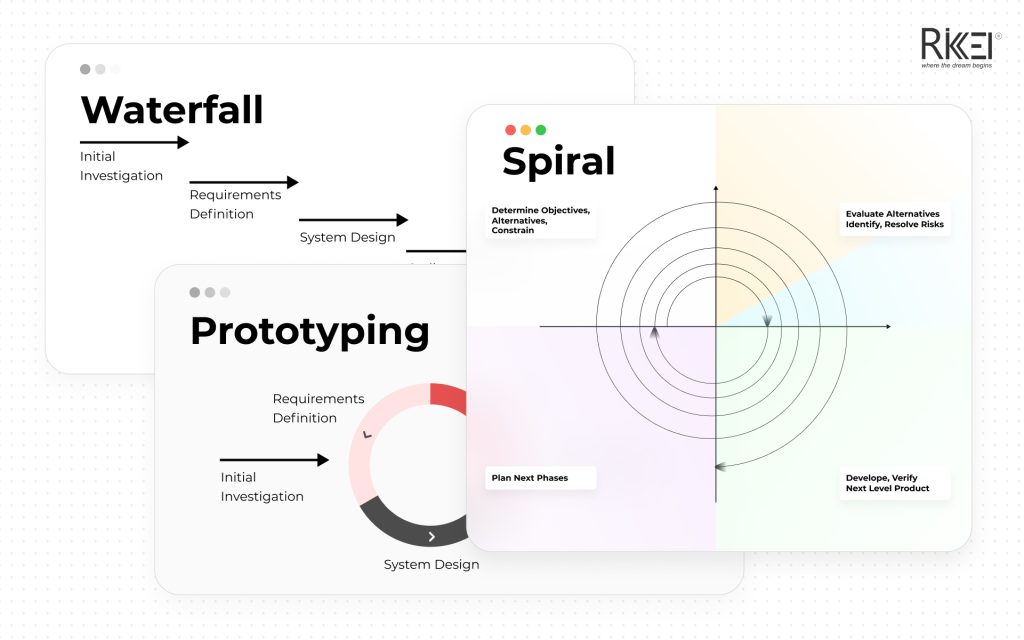
It is also a form of formalized communication. So you’re basically establishing a set of norms among a group of people that say this is how you’re going to operate and this is how you’re going to share information between each of you in particular ways; whether that’s documentation, discussion, or drawings on paper.
What is a good software development methodology like?
Effective procedures usually are well-defined steps combining with a good design and/or process philosophy. Choosing the proper technique for your project can help both the client and the development team with an accurate project timetable, increasing efficiency, and higher-quality deliverables that meet deadlines. This is good because most software development techniques prioritize building, repairing, synchronizing, and stabilizing. A software development plan needs a suitable methodology.
Furthermore, there are various models that integrate approaches, including open-source software development. Over the years, a number of frameworks have emerged, each with its own set of recognized strengths and flaws. One software development methodology framework may not be appropriate for all projects. Based on different technical, organizational, project, and team factors, each of the current methodology frameworks is best suited to specific types of projects.
Related Posts: What is MVP in Software Development?
10 Key Software Development Methodologies Explained
1. The Prototype Method
The Prototype Methodology is a software development process that enables developers to produce simply a prototype of a solution in order to show its functioning to clients. Before using this process to construct the actual application, make all necessary changes. The best aspect of this software development process is that it overcomes a slew of problems that sometimes arise in a typical waterfall paradigm.
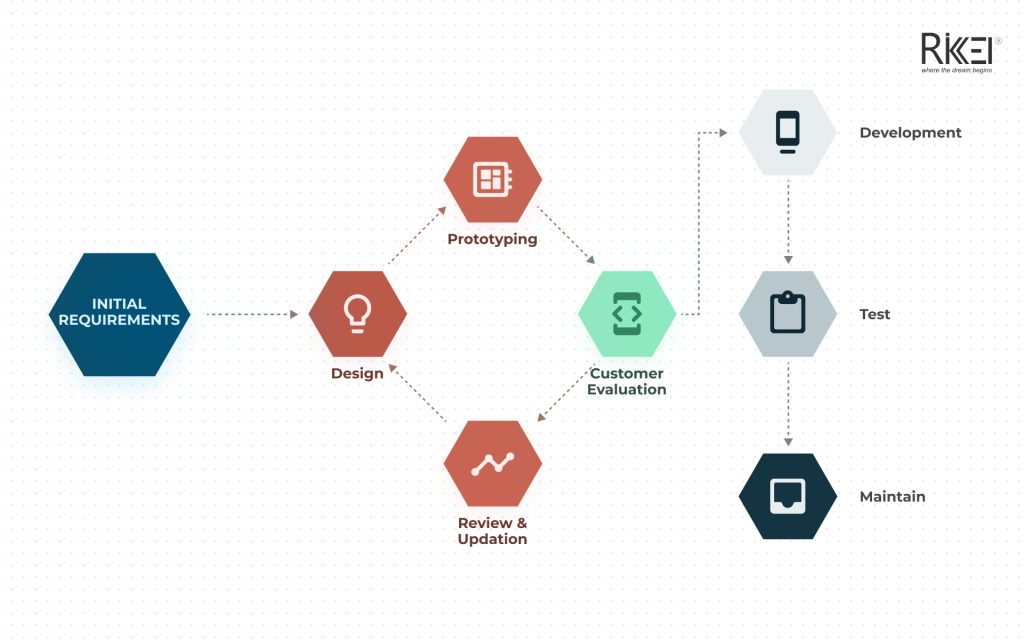
Advantages of the Prototype Method
- This strategy enables the detection of dangers and the correction of faults during the early phases of development.
- Developers and testers working on a prototype can simply scale it with the client’s anticipation, evaluate if they are on track, and make modifications if necessary.
- It is the most effective method of presenting and demonstrating the software solution to a client or investor.
- It provides developers with the opportunity to obtain valuable feedback from testers early in the development cycle, reducing unnecessary costs after launch.
- As a result of the regular communication provided by this strategy, the client and developer’s relationship strengthens.
Disadvantages of the Prototype Method
- Prototyping is normally done at the developer’s expense, so it should be done with as few resources as possible, otherwise, the organization’s development costs will be too high.
- Customers may request that the final product be provided shortly after seeing an early prototype.
- Clients are overly involved, and their interests are not always aligned with those of the software developers.
- It does not allow for too many changes in the project because they easily disrupt the existing workflow of the entire software development process.
- After seeing the initial prototype, customers may be dissatisfied or uninterested in the product.
Read more: 10 Common Risks in Software Development | How to Minimize?
2. The Agile Method
The Agile technique was created in reaction to rising dissatisfaction with Waterfall and other rigid, inflexible methodologies. This method is intended to accommodate change and the requirement to generate software more quickly. Agile prioritizes people and their connections and interactions over tools; it emphasizes customer collaboration throughout the development process; it adjusts to change rather than following a predefined plan, and it focuses on presenting working software rather than paperwork. Agile emphasizes team strengths and efficiency, as well as internal feedback from multiple departments and clients. The Agile strategy prioritizes client happiness, which teams achieve by continuously delivering working, tested, prioritized products.
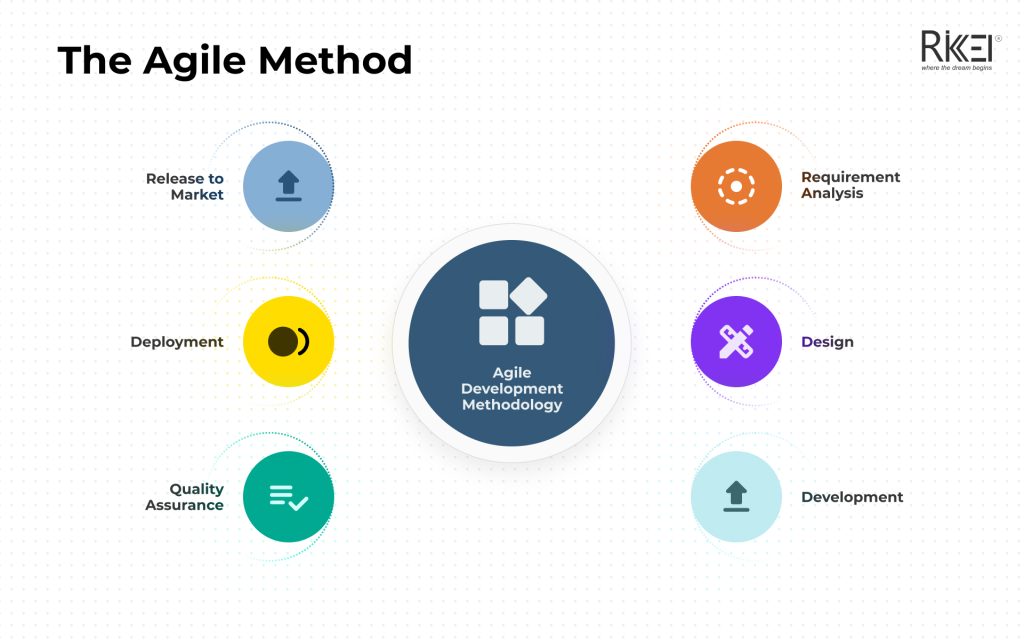
The agile software development approach is primarily concerned with delivering a finished product through collaborative efforts. It consists of short-term software development cycles known as iterations. Each iteration is well-organized and comparable to a little software project that typically lasts one to four weeks.
Iterations include duties like adding new features, evaluating and planning, designing, developing, testing, and documenting. The development team reassesses the project and prioritizes the backlog as the number of iterations grows. It is a good method that aids in product release and the creation of a better version at the conclusion of each iteration.
Advantages of the Agile Method
- Because small iterations allow for easier testing and maintenance with fewer errors, the agile methodology produces high-quality results.
- While working on a software product, it enables creative upgrades and alterations. Developers can experiment with various code tweaks.
- The agile methodology approach is adaptable, with less reliance on initial documentation. Changes implemented have no negative impact on the project.
- Because of the emphasis on clarity, there is frequent interaction and communication among the clients, developers, and members of the production process, resulting in a positive working relationship.
Disadvantages of the Agile Method
- Inconsistency in product requirements caused a lack of initial clarity and project vision.
- The difficulty in calculating the resources needed for a project. Unpredictable developments make estimating costs and resources difficult.
- Documentation is inefficient.
- There are no defined or stringent deadlines. Changes in specifications and requirements will result in inaccurate project completion estimates.
Read more: Outsource Software Development in 2023: Why & How
3. The Lean Method
Lean is both a workflow technique and a mentality, combining industrial ideas and practices and applying them broadly to a range of industries, including software development. The basic principles of Lean is to optimize the whole, eliminate waste, build quality , create knowledge, defer commitment, deliver quickly, and respect people. These principles, therefore, can help guide decision-making across the organization in a way that can help uncover potential issues and maintain a healthy organizational culture. Combining the best of Lean thinking and Agile software development processes can result in a healthy, long-term culture of innovation that benefits not only the development company but the entire system.
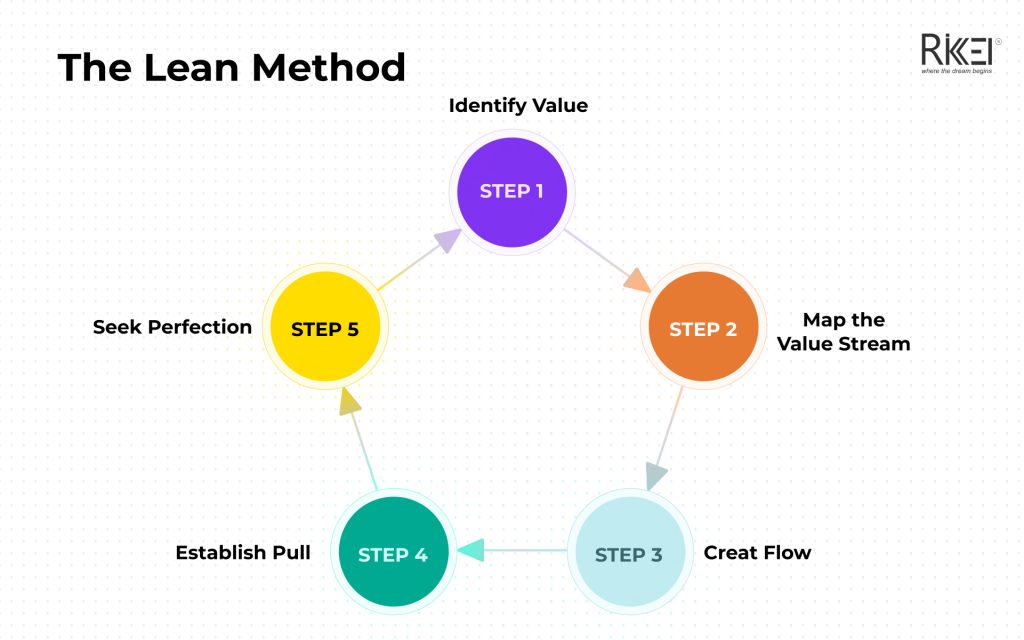
The Lean methodology focuses on the creation of low-cost, change-tolerant software. It is based on lean manufacturing and maximizes resources by producing software with one-third the amount of money, human labor, and production time. Lean workflow is minimal, and all types of excess, such as meetings, documentation, and so on, are eliminated.
Advantages of the Lean Method
- It is effective for budgeting.
- It enables the team to accelerate development. Most projects are completed in record time, exceeding deadlines.
- In its working process, the Lean methodology empowers the development team, enabling them to develop sharp decision-making skills.
Disadvantages of the Lean Method
- To maximize time and money, all judgments must be exact and definitive.
- To avoid unwanted deviation and time waste, flexibility is limited to keep the project on track.
- Teamwork, dedication, and advanced abilities are essential for this approach’s success.
- For proper requirements documentation, the Business Analyst in a lean project must have an adequate set of skills and experience.
Read more: 12 Different Types of Software Engineering
4. The Scrum Method
Scrum is a method of implementing the Agile approach that takes from Agile’s basic principles and concept – teams and developers should collaborate heavily and on a daily basis. Scrum is an iterative approach that puts the team first—experienced and motivated workers on smaller teams may find the most satisfaction with this approach, as it requires self-organization and self-management.
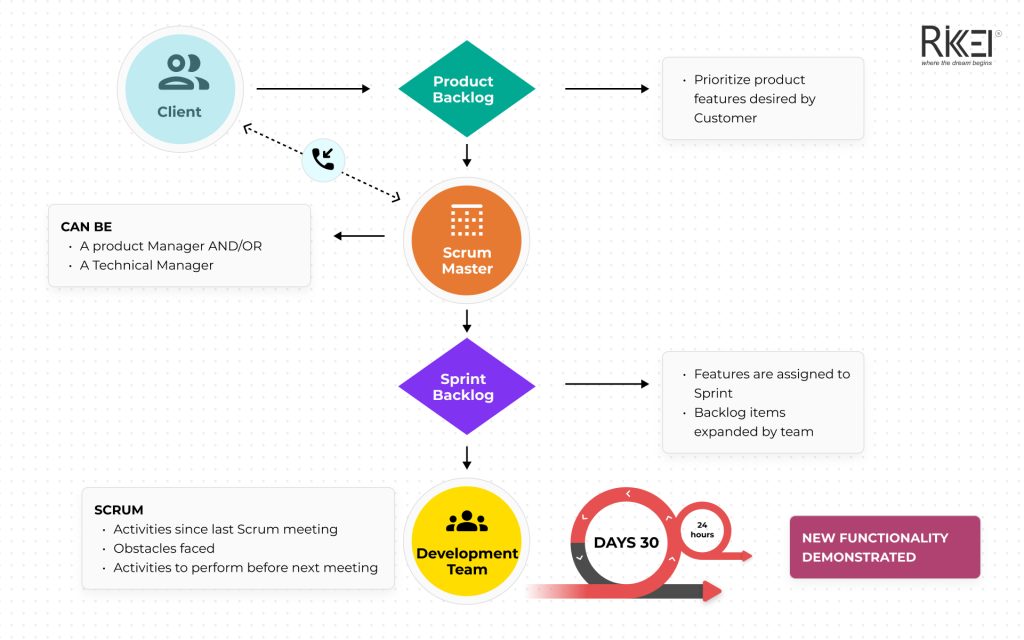
Scrum combines the structure and discipline of conventional software development approaches with the flexibility and iterative processes of newer Agile methodologies.
Advantages of the Scrum Method
- The main project decisions are made by the team.
- The daily meetings encourage the measurement of individual productivity, which leads to an improvement in the efforts of every team member.
- The Scrum technique identifies problems quickly, resulting in short meetings and easy team focus.
- Scrum allows for the flexible prioritization of customer-driven features. Documentation of business necessities is not required for successful development.
- Clients are in the production cycle because there is always something to evaluate at the end of each sprint.
- The feedback cycle is quick, which helps the project stay on track.
Disadvantages of the Scrum Method
- It is ineffective for junior or middle-level team players.
- For a project to be successful, time and cost estimation must be precise.
- For huge projects, this practice is less effective.
5. The Extreme Programming (XP) Method
Extreme Programming (or XP) focuses on developing higher-quality software by employing the best software development practices. XP, like most Agile techniques, has frequent releases in short development sprints that encourage change when it is required. In general, XP adheres to a set of values rather than steps, which include simplicity (build only what is necessary), communication (teams must interact and work together on every piece of software), continuous feedback, and respect.
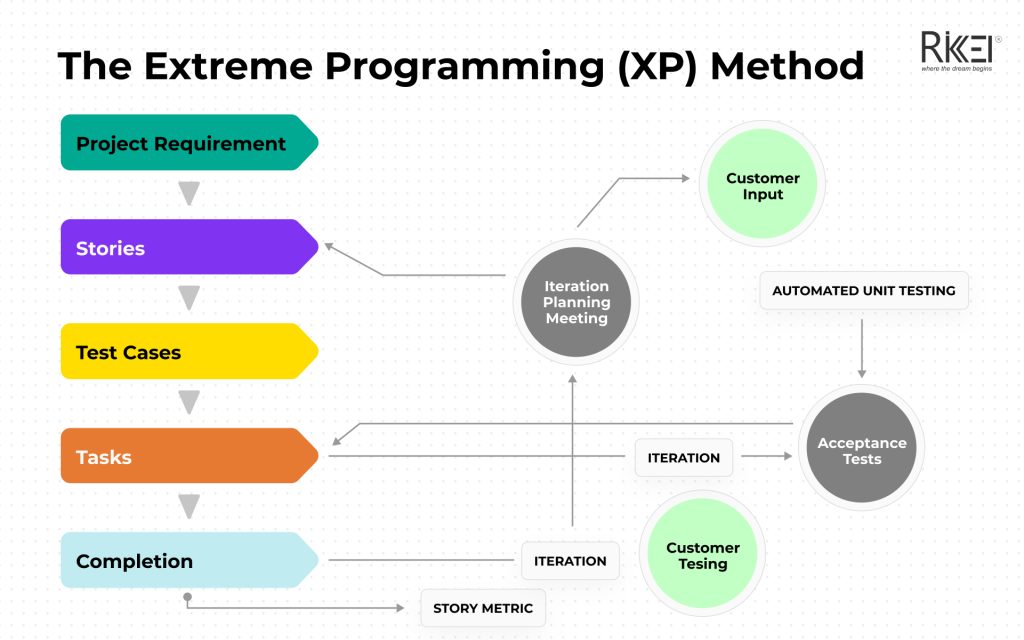
Extreme Programming necessitates that developers first design and comprehend the customer’s user stories—their informal descriptions of specific features.
Advantages of the XP Method
- The key benefit of Extreme Programming is the fact it allows software development organizations to save money and time on project implementation. Because XP prioritizes the timely delivery of finished products, you can easily save time. Extreme Programming teams save a lot of money by limiting documentation. They typically tackle difficulties through team conversations.
- Customer interaction is emphasized in extreme programming approaches.
- This model aids in the establishment of sensible plans and timetables, as well as in getting developers personally dedicated to their schedules, which is undoubtedly a significant advantage in the XP paradigm.
- This concept is congruent with most modern development methods, allowing developers to create high-quality software.
Disadvantages of the XP Method
- According to some experts, Extreme Programming is more concerned with code than with design. This could be a concern because the proper design is critical for software programs. It aids in their sale in the software market.
- Defect documentation in XP projects is not always good. Failure to document defects may result in the recurrence of similar faults in the future.
- This type of software development methodology offers regular meetings for clients’ convenience and get them involved with the developing process.
- It necessitates too many development modifications, which are extremely difficult for the software developers to do on a consistent basis.
- Because nobody knows the whole scope and needs of the project at the outset of the project, it is difficult to know the exact estimations of the work effort required to produce a quote using this methodology.
6. The Waterfall Method
Waterfall is the most classic and sequential method of software development. Although Waterfall is commonly regarded as an “old school” or outmoded method, understanding its history and structure might help you appreciate the flexibility of more recent methodologies. Waterfall, which was developed in 1970, was one of the most renowned techniques for several decades due to its plan-driven approach. Waterfall necessitates a great deal of organization and documentation up front. It’s broken down into self-contained phases or steps.
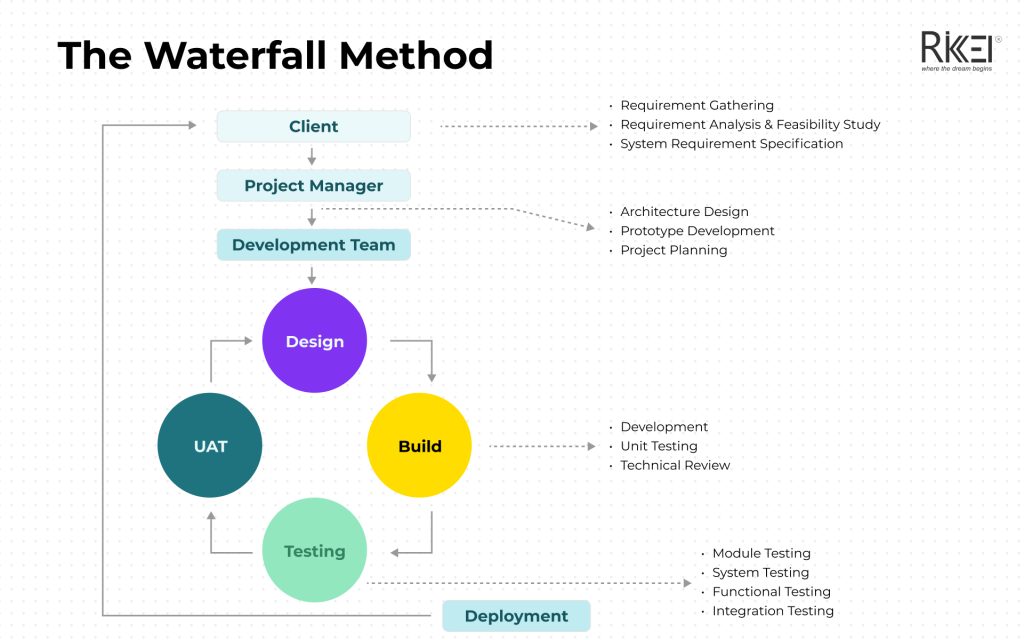
Waterfall is frequently used by large, plan-driven teams with a very clear idea of the project’s scope; nevertheless, development teams that don’t operate in a vacuum will likely discover that the flexibility and agility of more current approaches yield superior outcomes.
Advantages of the Waterfall Method
- The waterfall model is basic and easy to understand, and it employs methodology. That is why it is advantageous for inexperienced developers.
- Because of the model’s rigidity, project management is simple. Furthermore, each phase has its own set of deliverables and evaluation processes.
- In the waterfall method, the requirements are clearly understood/defined. It also works well for smaller projects.
- Practical planning and task scheduling are prioritized. This encourages developers to remain dedicated to a project.
Disadvantages of the Waterfall Method
- This method is not suitable for maintenance projects.
- The software in production only becomes operational at the end of the cycle.
- It works best when only well-defined needs are available upfront.
- Once a project has reached the testing stage, no updates or edits are permitted.
- It is an excellent strategy for small and medium-sized projects, but not for long-term or R&D initiatives.
- Not relevant to projects that are subject to changes along the road.
7. The Feature-Driven Development Method
Feature-Driven Development (FDD) is an incremental approach to software design that is based on the Agile methodology and is regarded as one way to execute it. FDD, like Waterfall, is commonly seen as an older technique, a forerunner to modern Lean/Agile implementations. FDD remains focused on the aim of producing working software regularly and is particularly client-centric, making it an excellent fit for smaller development teams.
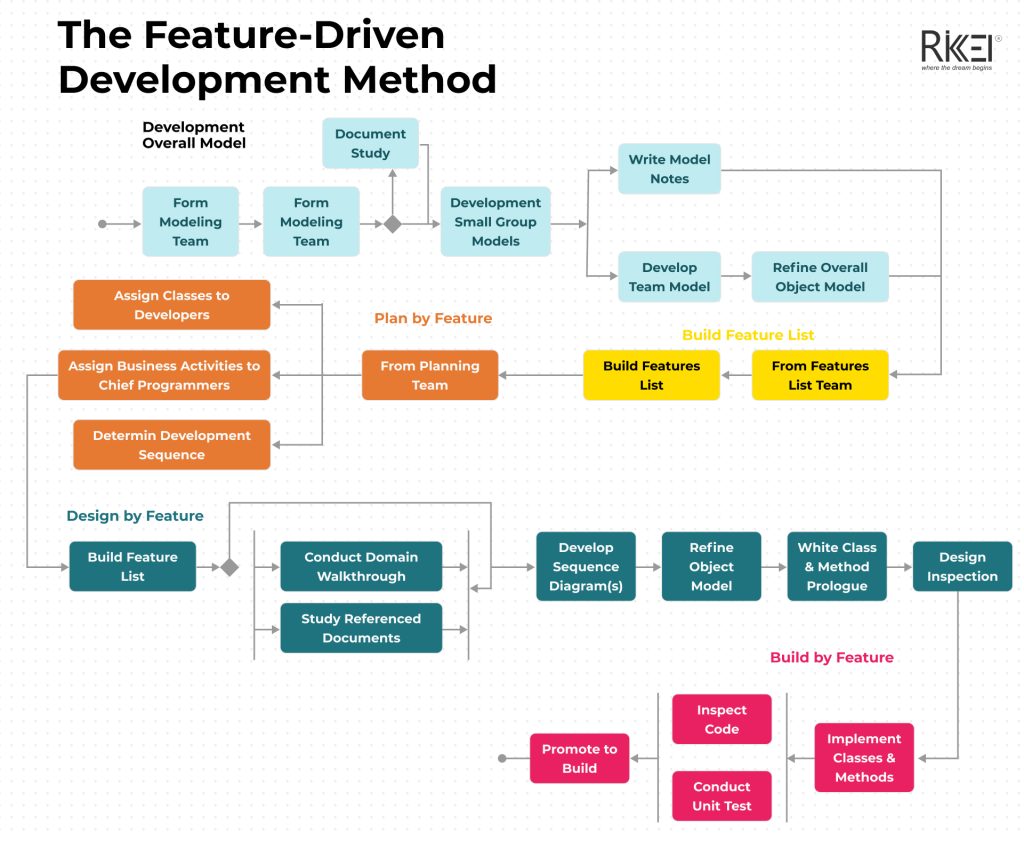
Furthermore, each feature that takes more than two weeks to develop and create must be further subdivided into individual features until it fulfills the two-week criteria. FDD’s inflexible structure makes it less appealing to teams that blend project-driven and break-fix work.
Advantages of the Feature-Driven Development Method
- This methodology is appropriate for large projects that must be completed successfully.
- Its five-step development process aids in the rapid delivery of software.
- F.D.D. allows numerous teams to work in parallel.
- This method’s criteria are on par with the highest industry norms.
- The simple five steps assist in completing work in a timely and easy manner.
- This paradigm is based on software development industry standards, allowing for easy development as well as industry-recognized best standards.
Disadvantages of the Feature-Driven Development Method
- It offers almost no documentation to project managers.
- It is not ideal for minor projects due to the work required.
- Individual software engineers cannot handle such a complex development pattern.
- This methodology’s effectiveness is entirely dependent on the Team Lead and his abilities.
8. The DevOps Method
DevOps is a prominent phrase that is gaining traction among all software development approaches due to the unequivocal benefits it provide to its consumers. The separation of Development and Operations is not the same as the birth of DevOps. These two departments work as a single team on all processes throughout the life cycle. This works for all firms at the same time. The continuous integration and continuous delivery models enable development and operational teams to do all development, quality assurance, security, and other operations concurrently. Businesses are increasingly turning to DevOps as an agile and lean approach that enables seamless collaboration across all phases of the development life cycle.
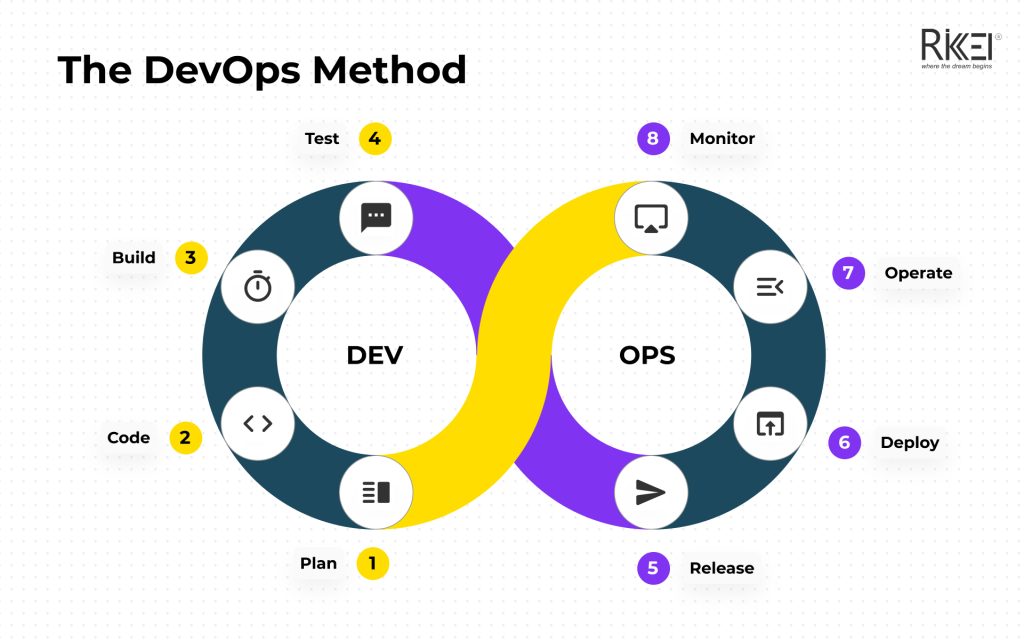
Advantages of the DevOps Method
- Multiple processes run concurrently, making the process quicker and simpler for organizations to complete on schedule. DevOps helps businesses to expand efficiently and achieve measurable business results by adjusting to market changes.
- Microservices and continuous deployment are two DevOps components that provide business continuity and timely upgrades. DevOps enables firms to continuously innovate and enhance their software offerings.
- As the products and infrastructure evolve, the produced products become more durable and secure, giving them a competitive advantage over their peers.
- This is a collaborative structure developed on strong responsibility and ownership principles.
Disadvantages of the DevOps Method
- DevOps necessitates a cultural shift. Yes, if you implement DevOps in your firm, cultural change is required, and businesses must restart their procedures in order to grow efficiently.
- Organizational upgradation can be quite a fuss for organizations to upgrade because at a systematic level, they will need to upgrade their entire system which can take up a lot of time and manpower.
- DevOps does not always produce results in terms of speed and security. Some firms may not guarantee both in a single step for some key software engineering projects, and you may need to establish a distinct plan for security at each stage of your DevOps workflow.
9. The Rapid Application Development (R.A.D.) Method
Rapid Application Development (RAD) is an efficient technique that produces considerably faster and higher-quality results than other software development methodologies. It is constructed to readily take advantage of software development. The primary goal of the fast application development technique is to shorten the overall software development process. Because it permits active user input in the development process, the goal is easily achieved.
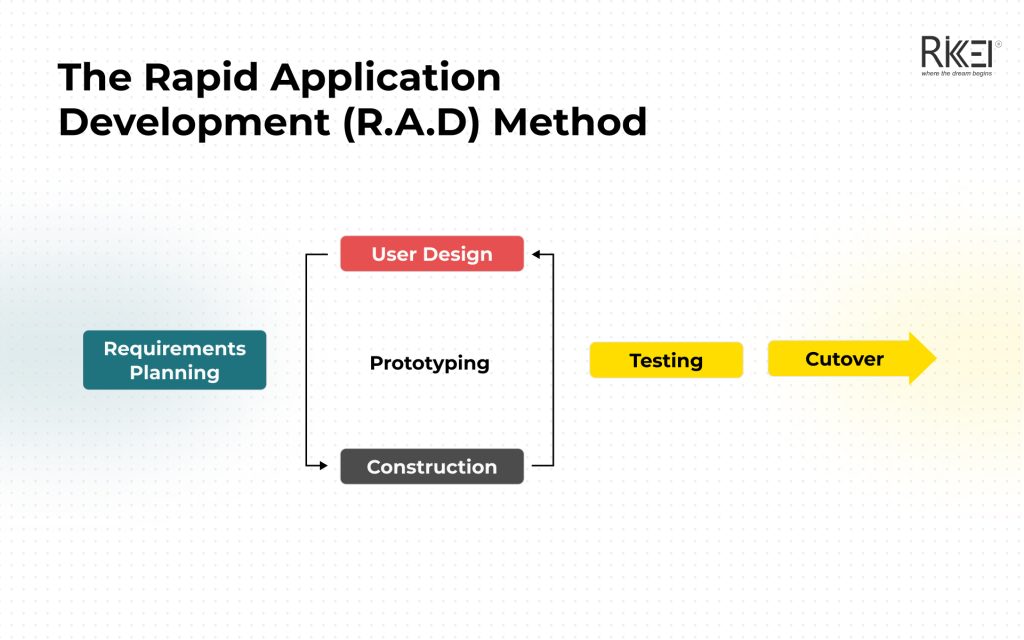
Advantages of the R.A.D. Method
- The rapid application development model reduces the risk and effort necessary on the part of the software developer.
- This paradigm enables clients to do speedy project reviews.
- This process promotes user input, which always provides room for improvement in any software development process.
- Natural prototyping – an approach for rapidly specifying and designing web apps, may result in fewer flaws.
- Each phase of RAD provides the client with the highest priority functionality.
Disadvantages of the R.A.D. Method
- This methodology relies on a great team as well as individual performance to accurately identify the business’s requirements.
- This methodology can only be used to build systems that can be modularized.
- This strategy necessitates highly trained engineers and a design team, which may not be feasible for every firm.
- This strategy is not suitable for usage by developers on low-budget projects due to the high expense of modeling and automated code creation.
- As a result, progress and difficulties are difficult to track, and there is no documentation to demonstrate what has been done.
10. The Spiral Method
The Spiral Approach is a complex model that concentrates on determining and mitigating project risks early on. With this software development process, developers begin on a modest scale, then investigate the risks associated in the project, devise a plan to address the risks, and lastly determine whether to proceed with the project to the next spiral iteration. The effectiveness of any Spiral Lifecycle Model is dependent on the project’s management being dependable, attentive, and informed.
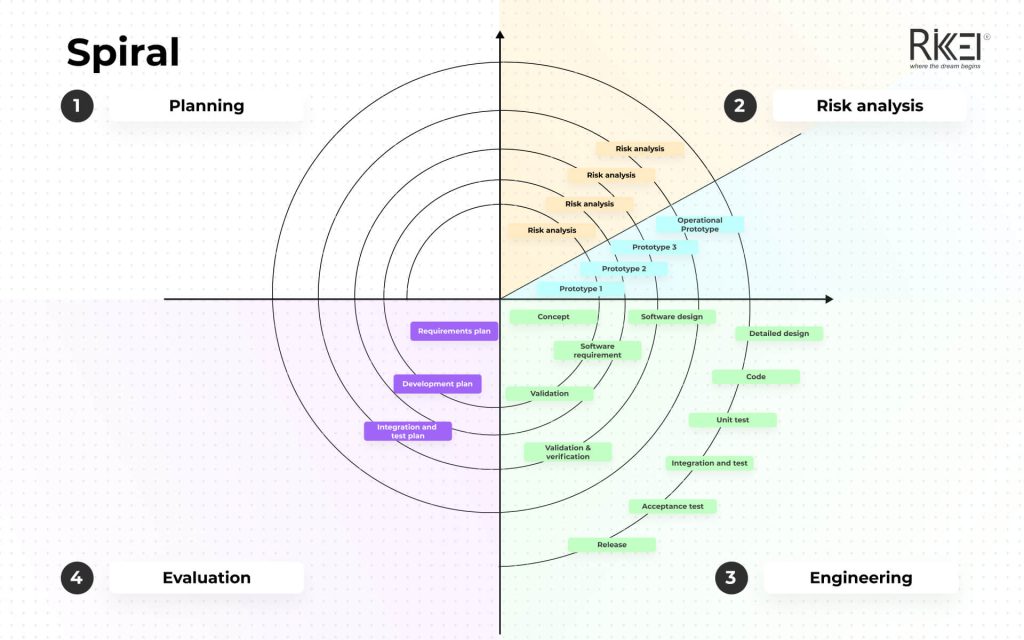
Advantages of the Spiral Method
- As a result of the extensive risk analysis performed, the avoidance of potential risks is significantly decreased using this approach.
- This paradigm is appropriate for large and vital projects.
- Additional functionality in the spiral model can be implemented at a later time.
- This model’s development is rapid, and attributes are added in a systematic manner.
- It is better suitable for high-risk projects when business requirements change on a regular basis.
Disadvantages of the Spiral Method
- In terms of development, it is undeniably a pricey paradigm to employ.
- Because the risk analysis phase is critical to the overall success of the project, failure in this phase may jeopardize the entire project.
- It is not suitable for low-risk projects.
- The major risk of this methodology is that it will never be completed.
- Documentation is more extensive because there are intermediate phases.
Read more: Complete Guide to Software Development Requirements
How to Choose The Right Methodology For Your Business?
The usefulness of software development approaches is seen in process optimization. Each model is unique in its own way. Based on objectives, aims to reach, and other considerations, each software development methodology is best suited to specific sorts of software projects.
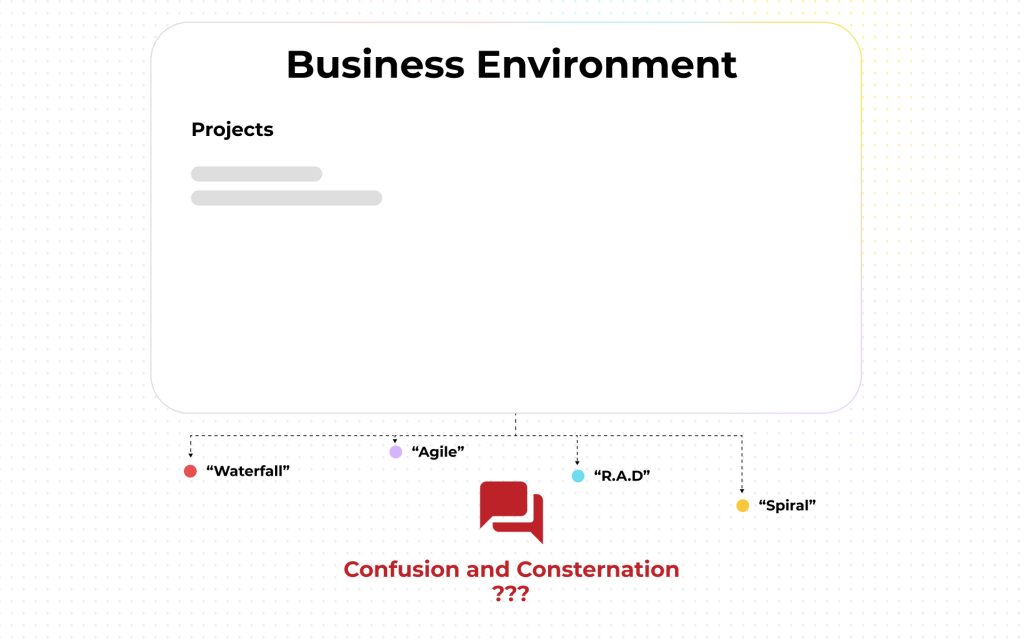
If you want to select the finest software development strategy for your company, you must examine six crucial factors:
- Determine the degree of pliability in the software needs.
- Know your customers.
- Determine the scope of the project.
- Determine the best development speed for the project.
- Consider the time difference if you have an offshore development team.
- Bring in the best developers.
Final Thought
The methodologies in software development listed above are critical and are commonly utilized in diverse software development projects. Furthermore, depending on the nature of the project, all of these famous software development approaches work effectively in some projects. It is common for one methodology that is suitable for one project to be incompatible with another. Furthermore, none of these software development approaches is perfect, as each has advantages and disadvantages. So, before choosing any of these development methods for their software development projects, software engineers must be familiar with all of these methodologies. A competent software development company is recommended for better results.
More From Blog

April 4, 2024
Big Data Performance: Maximize Your Business Value
In today’s data-driven world, organizations are constantly generating and collecting immense amounts of data to understand their customers more deeply. This data, often referred to as “big data,” holds immense potential for organizations to seek opportunities and overcome challenges. But accessing and analyzing big data isn’t enough to have proper strategies; organizations must pay attention to […]

April 4, 2024
How Real-Time Data Analysis Empowers Your Business
In today’s fast-paced business landscape, the ability to quickly make data-driven decisions has become a key differentiator for success. Real-time data analysis, the process of analyzing data as soon as it’s generated, has emerged as a powerful tool to empower business across industries. By leveraging real-time data analysis, organizations can gain timely and actionable insights, […]

April 4, 2024
Differences Between Data Science and Computer Science
Data Science and Computer Science are distinct fields overlapping in certain areas but have different focuses and objectives. The article below will help you clearly understand the differences and the close connection between the two fields. What is Data Science? Data Science is an interdisciplinary field that combines scientific methods, processes, algorithms, and systems to […]

March 28, 2024
Introduction to Data Visualization and Key Considerations for Businesses
In your opinion, what is data visualization? Your main goal is to communicate your recommendations engagingly and effectively, right? To achieve this, let’s immediately explore a method that can represent information with images. What is Data Visualization? Define data visualization and their roles in organizations First, you need to find the answer to the question: […]

March 21, 2024
How to Build an Effective Big Data Analytics Tool for Your Business
Building an analytics tool for a business brings several significant benefits, especially in today’s business environment where data is becoming larger and more complex. So how to build an effective analysis tool for businesses, follow the article below! Assessing Business Needs Assessing business needs involves understanding the requirements, goals, and challenges of a business or […]

March 14, 2024
What Is Oracle Business Intelligence? Their Role in Today’s Enterprises
Oracle Business Intelligence (BI) refers to a suite of tools, technologies, and applications designed to help organizations collect, analyze and present business data. The primary goal of Oracle BI is to provide actionable insights to support decision-making within an organization. Oracle BI encompasses a range of products that enable users to gather, process and visualize […]

